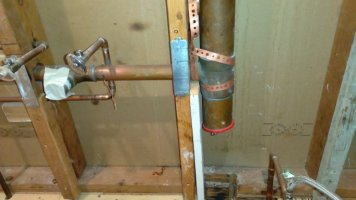wwhitney
In the Trades
You can add a 3x3x2 (or 3x3x1-1/2) combo between the two elbows just upstream of the wye branch inlet to bring the drain of a single lav in there. It won't mess up the wet venting.what about a 3" fitting on the long pipe that goes into the right side of the wye. could use a LT 3x3x2 LT tee? i would have to redirect the drain up stream to tie in but it think that is ok?
Not in the current orientation (dry vent take offs have to be vertical, not horizontal), and a dry vent for the WC would have to connect between the flange and that wye where the other drains join. But you don't need a dry vent for the WC, you can rely on the dry vent in the other bathroom to wet vent the WC. The IPC allows wet venting for up to 2 bathrooms at once.can the side inlet 90 in the pic be use just as a vent for the toilet? assuming i can redirect the sink drain.
That quarter bend with straight side inlet is only useful for two things: if the side inlet is vertical (at least 45 degree above plumb), then in the IPC you could use it as a dry vent takeoff with the quarter bend used for drainage (although if it's other than a WC , the quarter bend would have to be horizontal so the takeoff is straight up). Or you could use it to connect a small dry vent to a larger dry vent, when at least 6" above all the fixture flood rims.
Cheers, Wayne

